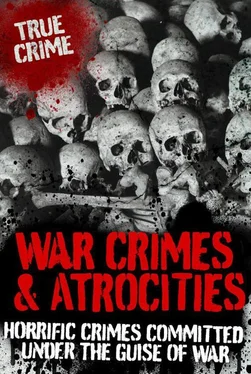CONSPIRACY THEORIES
Heydrich was taken to hospital, but Czech doctors were forbidden to attend to him. Instead, he was operated on by the personal physicians of Heinrich Himmler, his direct superior. However, Heydrich died of his wounds, apparently in agony. Himmler maintained afterwards that Heydrich had died of blood poisoning, as the result of an infection set up by the horsehair in the car’s upholstery. This odd diagnosis prompted speculation that Himmler was responsible for Heydrich’s death, as it was known that Himmler was both afraid of Heydrich and jealous of his close relationship with the Führer. Other conspiracy theories suggest that the hand grenade lobbed into the car by Kubis contained botulin, and was the result of an experiment in biological warfare by British scientists.
Whatever the truth of the matter, the outcome of the situation was that Hitler’s favourite had been assassinated. The Führer’s revenge, whatever form it would take, was sure to be savage indeed.
WADING IN BLOOD
Hitler immediately gave orders that his men should ‘wade in blood’ until they found the assassins. However, the Gestapo were unable to find them until its officers bribed a resistance fighter named Karel Curda with the promise of a million Reichsmarks, a new wife and a new name. Curda accepted the bribe and led them to the Moravec family, who had been sheltering the soldiers. The family were arrested, held captive and tortured. Mrs Moravec managed to commit suicide, taking a cyanide capsule. With typical sadism, the Nazis later put her head in a fish tank and showed it to her son, Ata. Not surprisingly, the young boy told the Gestapo where the assassins were hiding. Over 700 Nazi troops laid siege to a church in the city, but were unable to take the assassins alive; Kubis was killed in the gun battle, while Gabcik and others committed suicide to avoid being captured alive.
Not content with this outcome, Hitler planned to unleash untold violence on the entire Czech people, but was persuaded out of this by his advisers who told him that military productivity would be adversely affected in the region if he did so. Instead, the Nazis went on to arrest more than 13,000 people, and also committed one of the worst atrocities of the war: the destruction of the village of Lidice.
MASSACRE AT LIDICE
The massacre that took place at the small village of Lidice, just northwest of Prague, on the night of 9 June, 1942, was one of the greatest atrocities to hit Czechoslovakia during World War II. The whole village was completely eradicated along with the majority of its inhabitants. The violence started following the assassination of Reinhard Heydrich, the chief of the Security Police and deputy chief of the Gestapo. Two Czech men, Jan Kubis and Josef Gabeik bombed Heydrich’s car while he was on his way to the castle in Prague. Heydrich was badly wounded and died from his extensive injuries on 4 June.
The assassination incited the German people into taking revenge, and the village of Lidice took the brunt of their anger. Just five days after Heydrich’s death, ten trucks full of Security Police stormed the village and forcefully removed all the inhabitants from their homes. No one was allowed to leave the village and anyone trying to escape was shot. All the men and boys over the age of 16, 172 in total, were separated from their families and locked in a barn. The next day they were all lined up in groups of ten, and mercilessly shot. The massacre lasted from dawn until 4.00 p.m.
The women, as a whole, fared better than their menfolk but they were still subjected to excessive cruelty. Seven of the women were taken to Prague where they were shot. The remainder, 195 in total, were sent to Ravensbrüeck concentration camp in Germany. They were kept in squalid conditions with very little nourishment and 49 of the women died. Seven were gassed while the rest died from the appalling conditions and treatment they received at the hands of the Germans. The children, who the Germans considered to be the fittest, were chosen and sent to live with German people with a new identity.
The village itself was completed razed to the ground, and any building that was not destroyed by fire was dynamited and bulldozed so that nothing was left standing. Today there is no sign of the village of Lidice except for the open fields where the children once played. It is a stark reminder of the grim atrocities that took place in the long and harrowing war.
1941–45

In April 1941, German Nazi troops, together with troops from Hungary, Bulgaria and Italy, invaded what was then known as Yugoslavia in the Balkans. Their combined military force quickly overcame all opposition, and the region was soon occupied. The victors then proceeded to share out their gains, with Germany and Italy establishing a puppet fascist state in Croatia. Germany also occupied Serbia and annexed parts of Slovenia, while Italy occupied the coastal regions of Yugoslavia. Bulgaria annexed Macedonia, and Hungary took control in Backa, an area in the north of the country. This complex division of power meant that there were many conflicts in the country, not only between the occupied peoples and their rulers, but between the rulers themselves. However, the invasion proved disastrous in all regions for the 78,000 Jews who, since the 1930s, had come to Yugoslavia to escape persecution. Not only the Jews, but thousands of Roma people (commonly known as gypsies) also lost their lives, as the fascists began on their programme of genocide, exterminating entire communities whose ethnic backgrounds or religious beliefs they considered undesirable.
Croatia was perhaps the country worst affected, mainly because the Croatian fascist movement, the Ustasa (which still exists to this day), set about murdering as many Serbs, Jews and Roma as they could lay their hands on. Immediately after the invasion of the Axis powers, they murdered, tortured and raped thousands of Serbs, burning down Serbian villages all over the country. Within a year, almost two-thirds of the entire Jewish population of Croatia had been sent to concentration camps, including Jadovno, Loborgrad, Djakovo, Tenje, Osijek, Kruscica and the notorious Jasenovac. In Jasenovac alone, more than 20,000 Jews met their deaths. Not only this but Croatia also deported thousands of Jews to concentration camps in Germany and Poland, especially to Auschwitz.
JASENOVAC CONCENTRATION CAMP
After the invasion of Yugoslavia by the Axis powers, the fascist Ustasa established a so-called Independent State of Croatia, and they set up Jasenovac between August 1941 and February 1942. The Ustasa were a far-right political group who had a long history of animosity towards the Serbian people of the former Yugoslavia, with whom they shared citizenship. With the Nazis now in control, the Ustasa took the opportunity to persecute hundreds of thousands of Serbs, as well as Jews and Roma people. Thus it was that over 250,000 Serbs died in the Croatian concentration camps, along with 20,000 or more Jews. And this was only in a single year: 1941 to 1942.
Situated only a few miles outside the Croatian capital of Zagreb, Jasenovac was a complex of several camps: Krapje, Brocica, Ciglana, Kozara and Stara Gradiska. Krapje and Brocica closed down after four months, but the others were not dismantled until the liberation of the country at the end of the war. Stara Gradiska was initially a camp for political prisoners, but then became a camp for women in 1942.
Conditions in the camps were absolutely horrifying. Prisoners were forced to live in cold, insanitary conditions without enough food to eat. The Ustasa guards, who were paramilitaries, showed extreme sadism in their treatment of the prisoners, torturing and murdering their victims on a whim. Often, prisoners would be taken out and shot at killing sites nearby, for example at Gradina and Granik. Others were rounded up and sent to concentration camps in Germany and Poland: a total of 7,000 Jews were sent to Auchwitz. Yet others, who had skills useful to the Croats, such as carpenters, electricians and tailors, were used as forced labour in workshops.
Читать дальше













